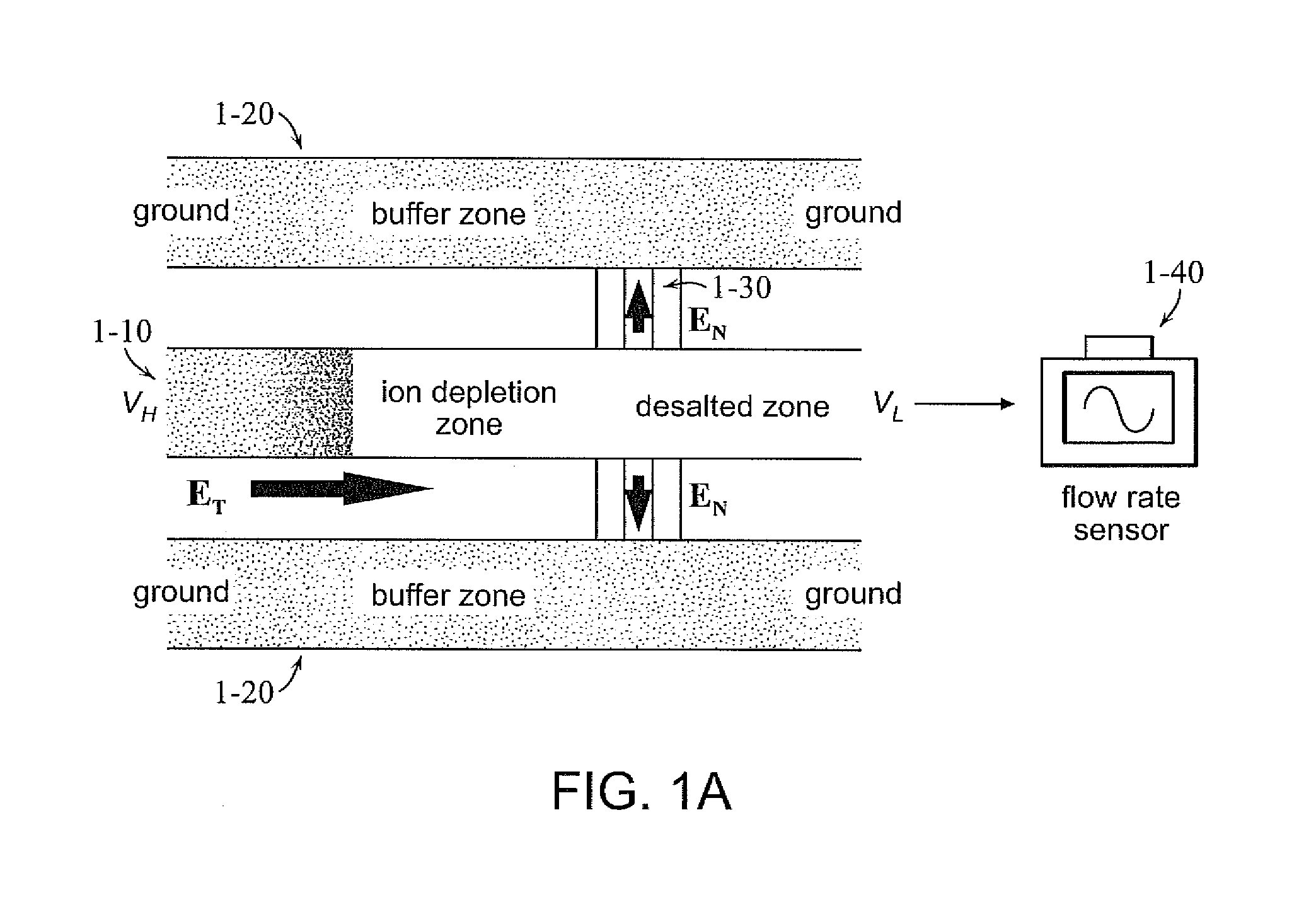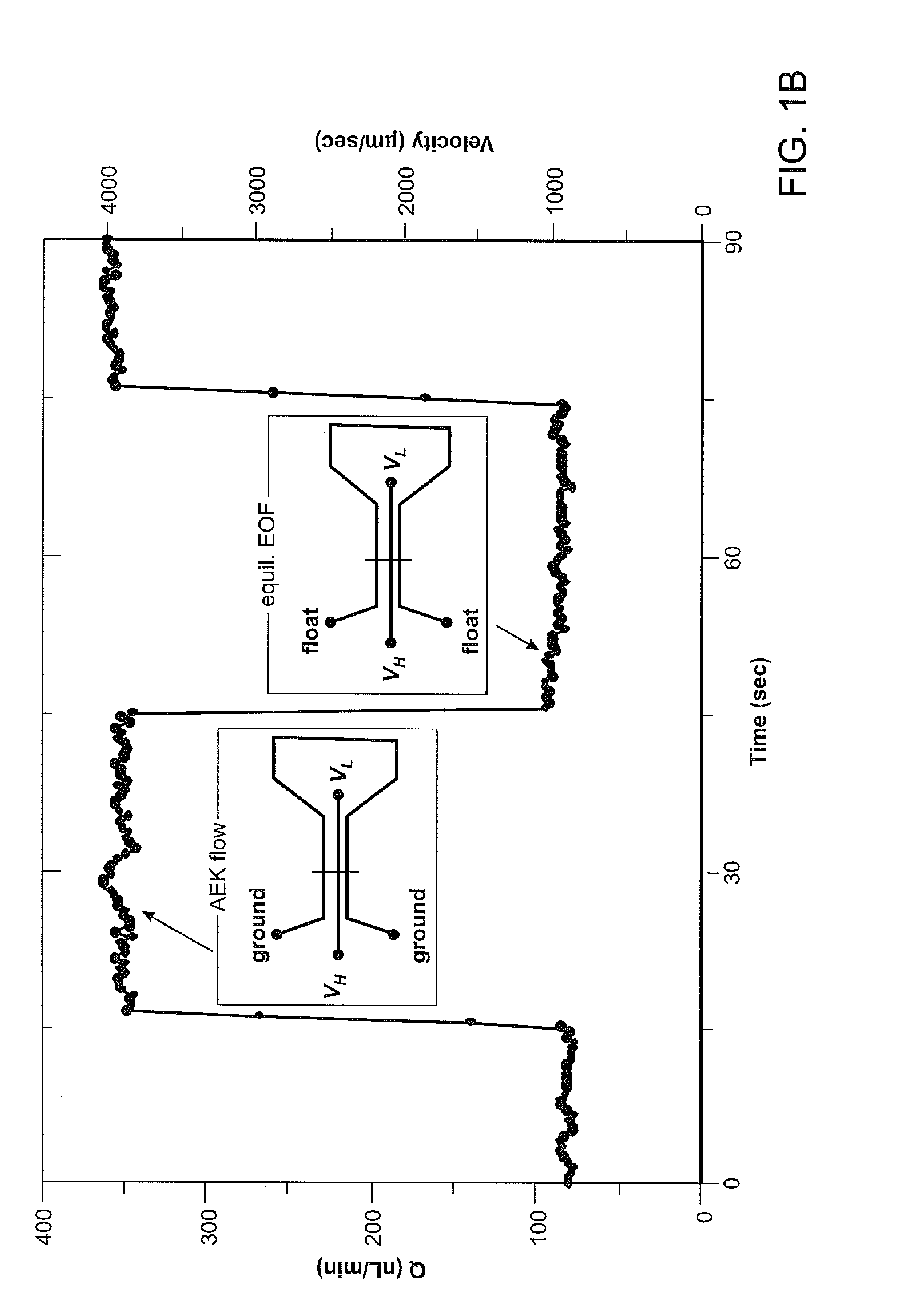Amplified electrokinetic fluid pumping switching and desalting
- Summary
- Abstract
- Description
- Claims
- Application Information
AI Technical Summary
Benefits of technology
Problems solved by technology
Method used
Image
Examples
example 1
Demonstration of Desalination
[0263]The desalination operation of micro / nanofluidic device at the unit device scale was experimentally tested. FIG. 11(a) shows the desalination experiment done with natural seawater (obtained from Crane beach, Ipswich, Mass., p11=8.4˜8.5). NaOH was added at 1 mM final concentration to the natural seawater in order to precipitate Ca2+ ions, which is known to cause significant precipitation in brine solution. This addition, however, did not decrease the salinity of the seawater significantly. Subsequently, seawater sample was physically pre-filtered in order to remove precipitations and large debris such as dirt, sand and seaweed (larger than the channel dimension). The seawater sample was then intentionally mixed with FITC (fluorescent dye as a molecular marker, 1 μg / mL, Invitrogen), polystyrene nanoparticles, r-phycoerythrin (r-PE, 1 ng / mL, Invitrogen) and human whole blood which had fluorescently stained white blood cells (WBCs) by Hoechst. Then the ...
example 2
Conductivity Measurement of Desalted Stream
[0266]The ionic concentration of seawater in the desalted stream is significantly lower than the original concentration, due to the repulsion of salts from the ion depletion zone. In order to quantify the concentration in a desalted stream, in situ conductivity measurement of desalted stream was done using embedded microelectrodes (shown in FIG. 10(a)). The potential drop (ΔV) between the microelectrodes was measured by Keithley 6514 electrometers and the current (i) through a “desalted” stream was obtained by Keithley 6487 picoammeters. The conductivity, □ can be simply calculated by the relation, □=i / |E|A, where i is the current passed through microelectrodes and A is the cross-sectional area of microchannel. E can be estimated by the potential drop divided by the gap between microelectrodes. For calibration, the conductivity of seawater of different dilution was measured using a benchtop conductivity meter (VWR sympHony conductivity mete...
example 3
[0269]The steady-state current required in our unit was found to be 1 μA (seawater desalination output at 0.25 □L / min in a device with a microchannel cross section of 100 □m×15 □m) or ˜30 □A (10 □L / min in a device with 500 □m×100 □m cross section). Thus, the power consumption was approximately 75 □W˜2250 μW per unit device. Therefore, the energy efficiency of this desalting mechanism is 5 Wh / L (75 □W / 0.25 □L / min)˜3.75 Wh / L (2250 □W / 10 □L / min). In addition to this, the energy for fluid delivery through a microchannel is also required and it is 0.041 mWh / L˜1.55 mWh / L. In case of flow rate of Q=0.25 □L / min in 100 □m×15 □m device, the power required for pumping through the microchannel can be calculated by the product of pressure times flow rate (p×Q). The pressure drop across the entire microchannel is given by 12 □QL / (wd3) where □ is the viscosity of seawater, and L, w, and d are the length, width and depth of microchannel, respectively. By adapting □=1.88 cp, L=2 cm,...
PUM
| Property | Measurement | Unit |
|---|---|---|
| Length | aaaaa | aaaaa |
| Length | aaaaa | aaaaa |
| Time | aaaaa | aaaaa |
Abstract
Description
Claims
Application Information
 Login to View More
Login to View More - R&D
- Intellectual Property
- Life Sciences
- Materials
- Tech Scout
- Unparalleled Data Quality
- Higher Quality Content
- 60% Fewer Hallucinations
Browse by: Latest US Patents, China's latest patents, Technical Efficacy Thesaurus, Application Domain, Technology Topic, Popular Technical Reports.
© 2025 PatSnap. All rights reserved.Legal|Privacy policy|Modern Slavery Act Transparency Statement|Sitemap|About US| Contact US: help@patsnap.com



